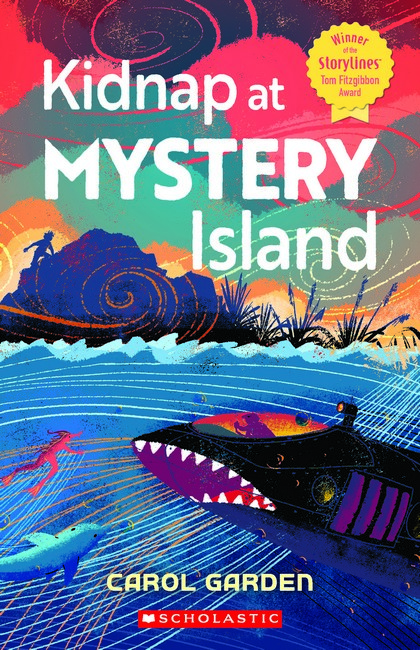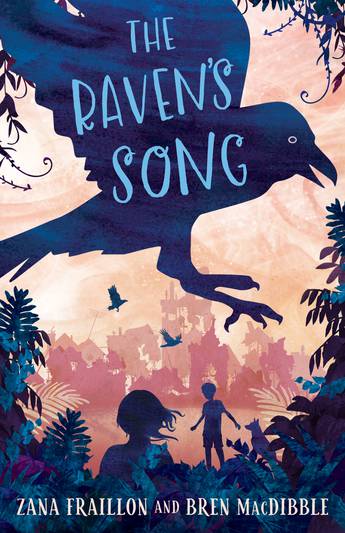Sarah Forster shares her thoughts on two middle-grade novels set in post-apocalyptic utopian worlds, packed with plenty of adventure, miracle technology, and imaginings of the future.

Kidnap at Mystery Island, by Carol Garden
I love the cover of this futuristic book, set in the ‘New World’ where our earth is conserved and all technology is created with its end use in mind. Smartwatches can be cast into the ocean where they will biodegrade quickly, and there are dozens of miracle technologies that exist to help humans live in harmony with the land.
The main characters are Dom, who we quickly understand is the son of our main baddie, Dezi, an Anti-Ec (anti-ecologist) who wants to mine the seabed in the Coromandel. Dom and Dezi live on a mysterious island that moves. Called Aparangi, it looks the same from every angle, and is full of every gadget your 21st-century baddie needs. Helijets, submarines, you name it, they’ve got it.
I love the cover of this futuristic book, set in the ‘New World’ where our earth is conserved and all technology is created with its end use in mind
Our other main characters are Zoe, Annie, and Mia, and their aunt and uncle Pearl and Blake Walker. They live in the ‘Dome’ in the Coromandel Peninsula, where they run a wave-converter power station and monitor the sea for smugglers and miners.
The book opens (after a brief preamble introducing Dom) as the Dome comes under attack from a group of Anti-Ecs. The group of baddies—Scarface, Ratface, and Red Man—find the hidden entrance to the Dome, but a range of Home Alone-inspired booby traps set by genius Mia stops them in their tracks.
The good guys have some awesome power at their disposal. Pearl is a former commando, and the commandos are always there to help out when needed. Each of the children has a special talent selected for them by their parents—these come in very handy. Annie can talk to marine creatures, Zoe can mind-speak, Mia is a tech genius, and Dom can blend into any background. I’m uncertain whether I didn’t notice the special talents of the adults in the book or if they are something that only the next generation has.
Each of the children has a special talent selected for them by their parents—these come in very handy
Given the title, it’s probably not too much of a spoiler to announce that at some stage, one of the girls is kidnapped, with the intent of scaring her aunt and uncle into turning a blind eye to Dezi’s mining.
There are a lot of things to love about this book—it’s kind of like if Enid Blyton had a lovechild (across the generations) with our own Brian Falkner. It is pacy, has cool tricks, cool tech, awesome gadgets, and just occasionally you get a snippet that reminds you of the Famous Five.
“Donning parachute rucksacks and helmets and carrying weapons they’d need for a topside assault, they used Ginnine’s guide rope to climb up the inside rock face of the lagoon.”
The only place I’ve ever heard backpacks referred to as rucksacks is in the Famous Five books. There are also plenty of escapes through unlikely hidden tunnels, and of course some clever subterfuge a la the Five.
There are a lot of things to love about this book—it’s kind of like if Enid Blyton had a lovechild (across the generations) with our own Brian Falkner
The characters have cool talents that help us identify them, as I explained earlier—but beyond that, I would love to have had a bit more depth to explain their actions. I did enjoy the disgusted reflection from the captured girl though, that she was put in the position of having to wait for a boy to rescue her.
When considering this book later, and all the convenient sci-fi elements, I realised there was a little bit of a fantasy/science-fiction line being crossed. The sci-fi elements I mentioned earlier, like tech that can be absorbed by the ocean without causing waste, aren’t fully explained, other than being part of the ‘New World,’ whereas the gifts the kids had were pure fantasy, with no possible scientific explanation. Likewise, the fact the sisters look nothing alike—which, while introducing diversity—was an interesting re-creation of genetic science.
The fact the sisters look nothing alike—which, while introducing diversity—was an interesting re-creation of genetic science
One of the girls is northern hemisphere European (I guess blonde?), Mia has black hair and dark eyes like someone of Middle-Eastern heritage, and Zoe’s skin colour was ‘rich dark chocolate’ (I have seen whole essays on why this is not okay—we don’t see ‘she has skin the colour of under-brewed tea’).
I mean okay, this is your book, go for it with the random reassignment of genes in a melting pot, but I don’t know. It just sat oddly, in what otherwise was a book with some pretty neat—and diverse—characters.
With all this said, I would absolutely recommend this for adventure tale lovers. Probably worth noting there is a lot of weaponry in case that’s something your family doesn’t like, but it’s refreshing to read something set in a world where all our climate troubles have been resolved—there is no racism, no sexism (uncle Blake is the main cook for the family), the economy is circular, and everyone lives peacefully. Unless they are baddies.

The Raven’s Song, by Zana Fraillon and Bren MacDibble
It’s been fascinating to read two books one after another where we spend time in a post-reconstruction utopia. In The Raven’s Song, one of my favourite New Zealand authors Bren MacDibble pairs up with one of my favourite Aussie authors Zana Fraillon to tell two linked stories—of a girl called Shelby, and a boy called Phoenix.
The Raven’s Song is a mythic triumph, threaded through with a song, the story of which has parallels throughout the book—the song of the Ravened Girl of the Bog.
Shelby lives with her da on a chicken farm and they are two of just 350 people in their township, which takes up 700 acres. The government set this way of life up 100 years ago, ensuring that everybody can live their life in a manner that ensures the honoured and natural world can continue its path to restoration.
The Raven’s Song is a mythic triumph, threaded through with a song, the story of which has parallels throughout the book
“Ours and Davy’s land being outermost this side of the township, this fence is our responsibility. If anything from the honoured and natural world outside gets in, that’s on us.”
Phoenix lives in a city with his four siblings, his Aunt Josie, and his Gran. As we meet him, he is visited by a giant raven wearing red shoes, and it doesn’t appear to entirely be a vision, because it leaves him a sack containing a toad.
“The raven has left a trail of muddy footprints all the way through the hall, down the stairs, into the kitchen and out the back door and why couldn’t the bird just have gone out the window?”
Phoenix has a best friend Charlie, and they communicate by text with him. This world has tech, including ‘Horizon,’ which is like an embedded computer in a window—whereas Shelby’s world has very minimal tech. Phoenix’s world has factories, and pollution, and pandemics—but he also has a seed diary, showing their civilisation has some inkling of what is ahead.
Phoenix’s world has factories, and pollution, and pandemics—but he also has a seed diary, showing their civilisation has some inkling of what is ahead
Shelby and her friend Davy need to fix their fence a couple of times, and each time they realise that the incursions are too neat to be animal-made. With Shelby’s encouragement, they follow a trail of possets, and go for a walk to see what lies beyond the fence, only to come across a broken-down city—and ultimately, an old man who appears to live there alone, bar an ancient and starving tiger.
Phoenix and his family find a necklace in the raven’s sack, that they recognise as their mothers, and take a trip to visit the tree they planted in her honour after her death. It soon becomes clear Phoenix isn’t the only sibling being haunted by a raven, and Walter finds a trail of black feathers, following them into danger. There is a near-drowning, but otherwise they all return home from their trip relatively unscathed.
Our two main characters are utterly human. Shelby, in her practical yet curious chicken-farmer manner, leads her to discover something horrific, and wants to help put it right; Phoenix, who has an unearthly feel about him, sees visions and portents, and acts as his brothers’ protector.
The utopia Shelby lives in now was only possible thanks to decisions made by the government of 100 years ago—who set them up in their seven hundreds. But before that… something happened that forced drastic action, something terrible.
Finally, a couple of minor spoilers. As we leave Phoenix, he is being readied for preservation in a cryogenic chamber, to be woken up when the disease he harbours has a cure. The children don’t meet until quite late in the book, when Shelby discovers a museum after following the old man on the other side of the fence. There are a lot of children in what she sees as giant eggs in an abandoned museum which tells the story of a great pandemic.
I think this is a must-read novel for anybody who wants a vision of how the future might be better, and it’s a worthy companion to Bren’s earlier novels
“When it was over, all the governments had got together and pledged that from now on, no sickness would ever be able to cross borders again… No one had talked about being the ones locked in with the sickness.”
There is a scene near the end of Raven’s Song which reminded me strongly of one of the most horrific scenes of Elizabeth Knox’s Wake, when the children are packed away (if you know, you know). It made it hard for me to keep reading at a certain point. But because this is ultimately a hopeful book—as in hopeful that everybody will do the right thing in the end, and it will all work out—this doesn’t stop me whole-heartedly recommending it.
I think this is a must-read novel for anybody who wants a vision of how the future might be better, and it’s a worthy companion to Bren’s earlier novels. The storytelling and characterisation are superb, and this book has all the hallmarks of a new middle-grade favourite.

The Raven’s Song
Written by Zana Fraillon and Bren MacDibble
Published by Allen & Unwin
RRP: $19.00

Sarah Forster has worked in the New Zealand book industry for 15 years, in roles promoting Aotearoa’s best authors and books. She has a Diploma in Publishing from Whitireia Polytechnic, and a BA (Hons) in History and Philosophy from the University of Otago. She was born in Winton, grew up in Westport, and lives in Wellington. She was a judge of the New Zealand Book Awards for Children and Young Adults in 2017. Her day job is as a Senior Communications Advisor—Content for Te Herenga Waka—Victoria University of Wellington.



